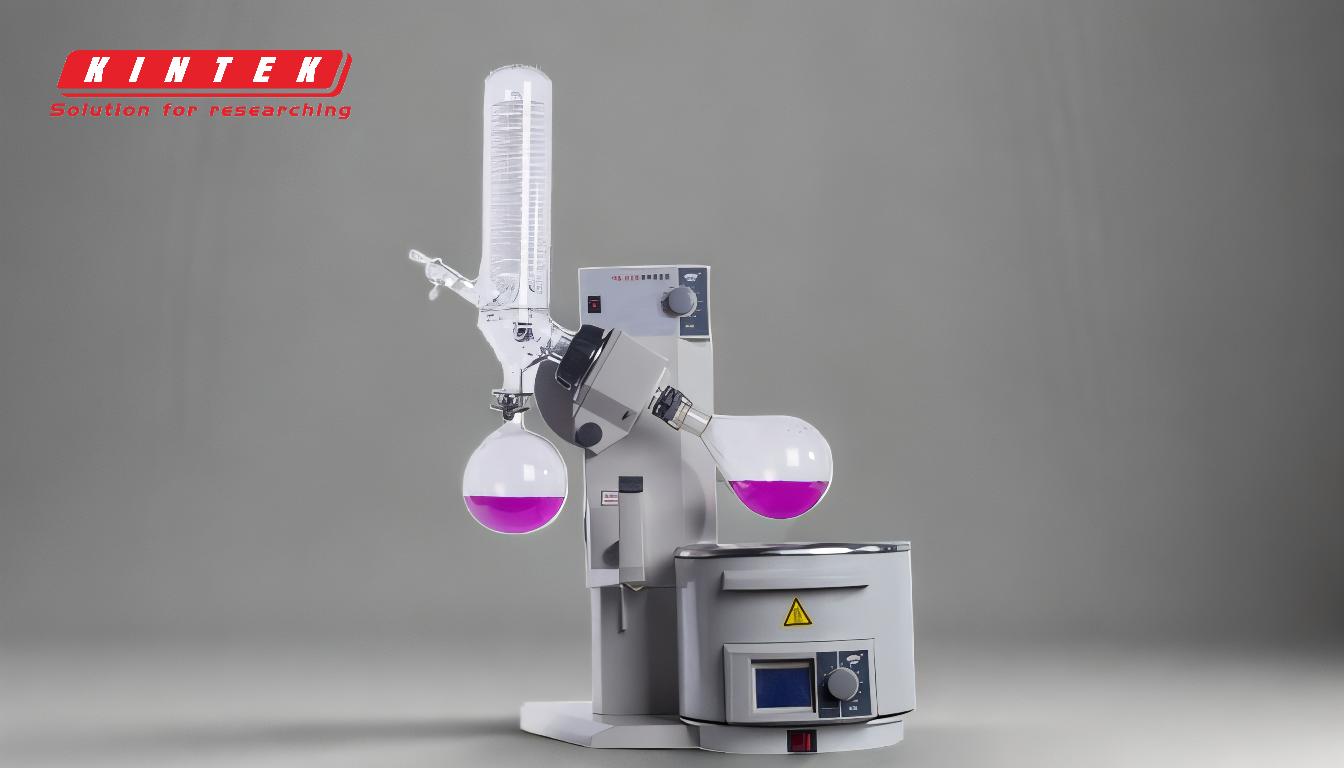A rotary evaporator, commonly referred to as a rotovap, is a laboratory instrument used for the efficient and gentle removal of solvents from samples through evaporation. Its working principle is based on the reduction of pressure within the system, which lowers the boiling point of the solvent, allowing it to evaporate at lower temperatures. The process involves rotating a flask containing the sample in a heated water bath, creating a thin film of the solution on the inner walls of the flask. This increases the surface area for evaporation, ensuring uniform heating and reducing the risk of bumping. The solvent vapors are then condensed and collected in a separate flask, leaving behind the concentrated compound. This method is particularly useful for volatile and heat-sensitive materials, as it minimizes thermal degradation.
Key Points Explained:

-
Reduction of Boiling Point Under Vacuum:
- The primary principle behind a rotary evaporator is the reduction of the solvent's boiling point under vacuum conditions. By lowering the pressure inside the system (typically to around 1 torr), the boiling point of the solvent is significantly reduced. This allows the solvent to evaporate at much lower temperatures than it would under normal atmospheric pressure.
- Example: Solvents like dimethylformamide (DMF) and dimethyl sulfoxide (DMSO), which have high boiling points under normal conditions, can be distilled at temperatures as low as 50°C when the pressure is reduced to 5 torr.
-
Rotation of the Flask:
- The flask containing the sample is rotated at a constant speed, which creates a thin film of the solution on the inner walls of the flask. This thin film increases the surface area available for evaporation, which speeds up the distillation process.
- The rotation also ensures uniform heating of the sample, reducing the risk of localized overheating and bumping (sudden, violent boiling that can cause sample loss or contamination).
- Benefit: This method is particularly beneficial for heat-sensitive materials, as it minimizes the time the sample is exposed to heat, thereby reducing the risk of thermal degradation.
-
Heating and Evaporation:
- The sample flask is partially immersed in a heated water bath, which provides the necessary thermal energy for evaporation. The temperature of the water bath is carefully controlled to ensure that the solvent evaporates efficiently without overheating the sample.
- The combination of reduced pressure and controlled heating allows for the gentle removal of solvents, preserving the integrity of the solute or analyte.
-
Condensation and Collection:
- As the solvent evaporates, the vapors are directed through a vapor duct into a condenser. The condenser cools the vapors, causing them to condense back into a liquid.
- The condensed solvent is then collected in a separate flask, while the concentrated compound remains in the original flask.
- Efficiency: This process is highly efficient, as it allows for the recovery of the solvent, which can often be reused, and the isolation of the desired compound in a concentrated form.
-
Vacuum System:
- A vacuum pump or water aspirator is used to create and maintain the reduced pressure within the system. The vacuum is essential for lowering the boiling point of the solvent and ensuring efficient evaporation.
- Consideration: The choice of vacuum system depends on the specific requirements of the application, including the desired vacuum level and the volatility of the solvent.
-
Applications and Suitability:
- Rotary evaporators are widely used in chemistry, biochemistry, and pharmaceutical laboratories for the concentration of solutions, purification of compounds, and removal of solvents.
- They are particularly suitable for volatile and heat-sensitive materials, as the gentle evaporation process minimizes the risk of thermal degradation.
- Example: In the pharmaceutical industry, rotary evaporators are used to concentrate active pharmaceutical ingredients (APIs) without compromising their stability or efficacy.
-
Advantages Over Traditional Distillation:
- Rotary evaporators offer several advantages over traditional distillation methods, including faster evaporation rates, lower operating temperatures, and the ability to handle heat-sensitive materials.
- The continuous rotation of the flask ensures uniform heating and prevents bumping, which can be a common issue in traditional distillation setups.
In summary, the rotary evaporator is a versatile and efficient tool for solvent removal and sample concentration. Its working principles—reduced pressure, rotation, controlled heating, and condensation—make it an indispensable instrument in many scientific and industrial applications. By understanding these principles, users can optimize the performance of their rotary evaporator and achieve the best results for their specific needs.
Summary Table:
| Key Principle | Description |
|---|---|
| Reduction of Boiling Point | Lowers solvent boiling point under vacuum for gentle evaporation. |
| Rotation of the Flask | Creates a thin film for faster evaporation and uniform heating. |
| Heating and Evaporation | Controlled water bath heating ensures efficient solvent removal. |
| Condensation and Collection | Condenses solvent vapors for recovery and isolates concentrated compounds. |
| Vacuum System | Essential for maintaining reduced pressure and efficient evaporation. |
| Applications | Ideal for volatile and heat-sensitive materials in chemistry and pharmaceuticals. |
| Advantages Over Distillation | Faster evaporation, lower temperatures, and reduced risk of bumping. |
Optimize your lab processes with a rotary evaporator—contact us today to learn more!















